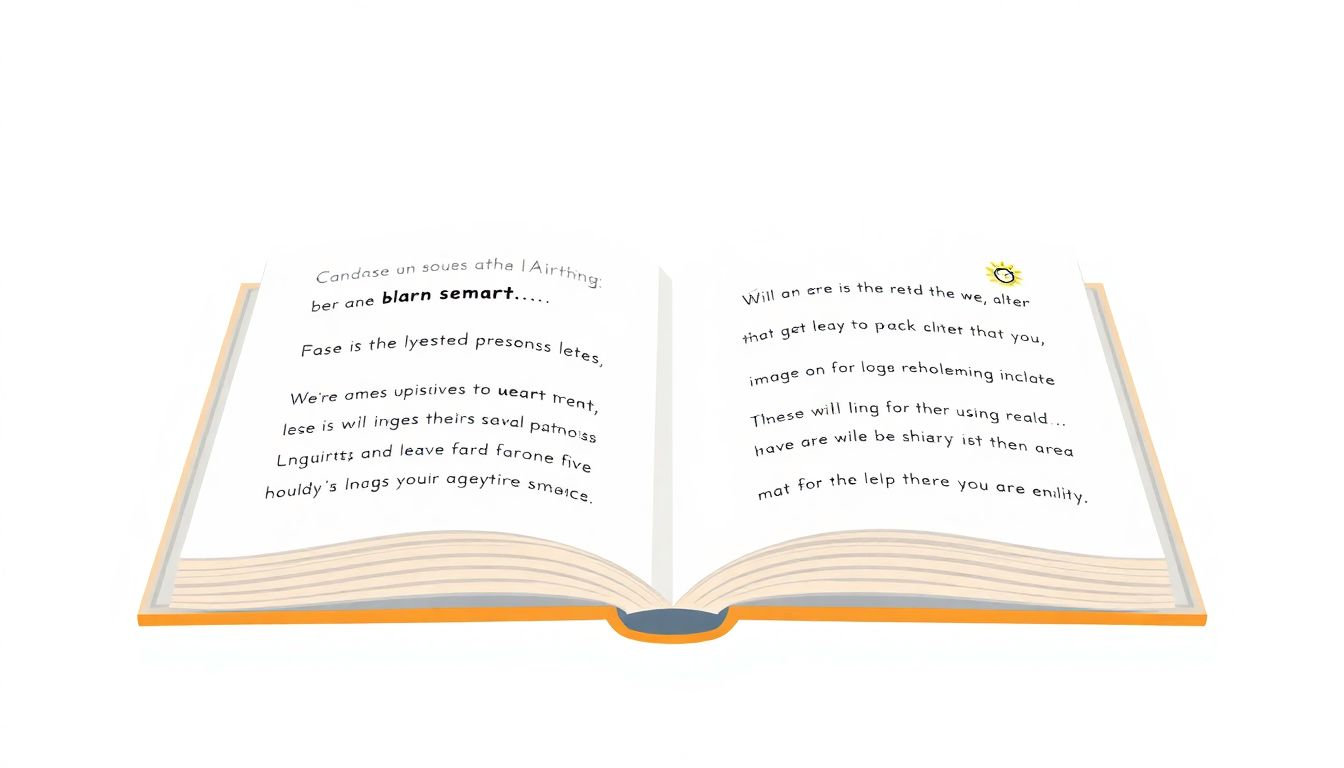Writing educational content isn’t always easy. Maybe you’ve stared at a blank screen, unsure how to even begin or struggled to keep your audience interested without drowning them in info—trust me, we’ve all been there.
Good news is, creating helpful, clear, and engaging educational material doesn’t have to be a headache. Stick around, and I’ll walk you through simple steps that’ll help you write content your audience will genuinely enjoy—and even learn from (fancy that!).
Let’s jump right into it.
Key Takeaways
- Identify exactly who your reader is so you create content that fixes their problems or teaches clearly.
- Do detailed research from multiple reliable sources, keeping your notes organized for easy reference.
- Structure content into short, clear sections, with headings, bullet points and summaries for quick reading.
- Keep language conversational and simple; avoid jargon or complicated words.
- Back up statements with credible statistics or expert sources to gain audience trust.
- Add visuals or graphics to make ideas clearer and more memorable for the reader.
- Include interactive elements like quizzes and polls to encourage reader participation.
- Double-check your writing to avoid mistakes or factual errors, preferably having others proofread.
- Regularly update your materials to stay accurate, timely, and valuable to readers.

Step 1: Know Your Audience
Before anything else, you’ve got to figure out who you’re writing your educational content for, because there’s a big difference between writing for kids and adult learners. If you’re writing for children, using simple language, relatable examples like funny prompts for kids and plenty of playful visuals is key. For older students or professionals, you might need a more detailed and structured approach that digs deeper into the subject matter. A practical tip is creating an audience profile—imagine a real person with interests, motivations, learning preferences, and challenges. It doesn’t need to be complex—just some bullets on age range, educational background, preferred learning style (visual, auditory or kinesthetic), and their likely goals or issues. Remember, you’re writing to help someone solve a problem or learn something new, so always keep that individual in mind when developing your content.
Also, avoid the mistake of thinking your audience automatically knows what you know—I once read an educational piece filled with technical language made for beginners, which completely missed the mark. Don’t assume anything; break down complicated stuff into manageable pieces. Your readers will thank you by coming back again.
Step 2: Research Your Topic Thoroughly
You can’t just wing it when creating great educational content—fact-checking and proper research are your best friends here. Check multiple sources and explore different perspectives, which helps you give balanced, useful information. Websites like Google Scholar, JSTOR, or educational YouTube channels like CrashCourse can be amazing places to start researching your topic.
Speaking from experience, it helps to keep notes organized—either in a Word doc, Google doc, or even using handy research tools like Evernote. Saving your resources also speeds up any future revisions. Trust me, you’ll thank yourself down the line. Don’t overlook checking for relevant data, trends, or current statistics that your readers would appreciate. For example, knowing that active learning techniques improve student performance by around 6% and cut failure rates by 55% can reinforce the importance of hands-on strategies in your article (source: PNAS).
Remember, if you really know your stuff, your confidence shows through in your writing—your audience notices and appreciates it. A solid research background isn’t just credibility; it genuinely makes your content better.
Step 3: Structure Your Content Clearly
Writing educational content isn’t just about dumping information in one big paragraph—structure means everything to learners on all types of devices, especially mobile. Organizing your writing into digestible chunks helps readers navigate more quickly and retain more information. Break down large ideas into smaller steps or sections, clearly marked by descriptive headings and subheadings to make the information scannable.
Bullet points, numbered lists, and short paragraphs are also your best bet for enhancing readability. For example, if you’re explaining how to create an interactive ebook quickly, write out clearly numbered steps instead of putting everything into bulky paragraphs. Another neat trick is to give a brief summary in each heading so your readers instantly understand what they’re about to learn.
If I’m teaching steps or instructions myself, I love adding quick recaps at the end of sections because it reinforces learning. Remember, crafting clear structure makes your content easy to navigate—so readers get exactly what they need without frustration.

Step 4: Write in Simple and Clear Language
The key to great educational material is simplicity and clarity, not fancy vocabulary or literary skill.
Think about explaining a concept to a friend, keeping sentences short and sweet, avoiding jargon like the plague, and breaking down complicated ideas into easy, bite-sized pieces.
Using conversational language like “you” and “we” naturally draws your reader in, making them feel you’re guiding them personally rather than lecturing them.
When crafting content for younger audiences, for instance, you might introduce creative topics like winter writing prompts to spark their imagination while keeping the explanations straightforward.
One trick that’s always helped me is reading content aloud because awkward phrases jump out, and you’ll naturally simplify complicated points when spoken aloud.
Bottom line: never sacrifice clarity to make yourself sound smarter—your readers won’t appreciate having to reach for a dictionary mid-paragraph.
Step 5: Support Your Content with Credible Sources
Nothing tanks trust faster than using shady or inaccurate sources in your content.
Your readers expect reliable, useful information, so always back up claims with credible evidence like peer-reviewed studies, official stats, or reputable websites.
For example, instead of vaguely stating active learning helps students, you can mention studies proving active learning improves student performance by 6% and cuts failure rates by 55% compared to traditional lectures (source: PNAS).
Clearly link sources right where readers need them—no vague mentions like “studies say” without direct proof.
Make sure your sources are recent and trustworthy, avoiding sketchy sites or unverified claims—you want to build loyalty with readers through accuracy, not sensationalism.
Step 6: Use Visuals to Improve Learning
Visual elements are more appealing and memorable than text alone, significantly boosting how well students or readers understand new information.
Numbers speak volumes: educational content backed by visuals like images, videos, or diagrams increases retention and reader enthusiasm noticeably, so don’t rely solely on text (source: Shift eLearning).
Tools like Canva or even PowerPoint office templates come in handy for quickly creating graphics that simplify concepts at a glance.
For example, if you’re explaining complex steps like how to format dialogue clearly, adding visual examples such as dialogues formatted in speech bubbles can drastically simplify understanding.
One last tip—alt-text is your visual content’s BFF, ensuring accessibility and helping visually impaired readers engage equally with your educational materials.
Step 7: Make Your Content Interactive and Engaging
If you want your readers or students actively involved, simply giving them a wall of text won’t cut it these days.
Polls, quizzes, interactive lessons, and even easy-to-implement games transform passive readers into active participants, improving their understanding and memory.
Trends show that interactive elements like augmented reality and learning games have grown popular recently, highlighting the value of getting users involved (source: Forbes).
You can keep interactions simple without coding—embedding free quizzes from Google Forms or Quizlet in your content adds engagement effortlessly.
And here’s a quick pro tip: providing prompt feedback after interactions reinforces lessons learned immediately, turning casual users into loyal fans.
Step 8: Format Content for Quick Reading
Let’s face it, readers skim before they dig in, especially on smartphones, making skimmable format essentials like headings, bullet lists, and short paragraphs your content’s new best friends.
Always divide long content into easy-to-scan sections using subheadings every 200–300 words to help readers spot needed info quickly.
Bullet points highlight key tips or steps at a glance, ensuring vital info isn’t missed.
For content that explains processes (like detailed instructions to publish a book without hiring an agent), clear numbered steps simplify tasks, making the reader’s journey effortless.
Bonus hack from personal experience: add mini-summaries at the end of longer sections to reinforce main points, helping readers quickly review and absorb before moving on.
Step 9: Check for Accuracy and Quality
Nothing ruins your credibility quicker than sloppy mistakes, factual inaccuracies, or unprofessional errors slipping through your content.
After writing your initial draft, set it aside to revisit with fresh eyes later—I catch ten times more mistakes that way.
Pay extra attention to spelling, grammar, formatting consistency, and factual correctness by double-checking with reliable sources and dedicated proofreading software like ProWritingAid or AutoCrit.
An even smarter step? Have a coworker, editor, or beta reader go over your material as they’ll spot overlooked issues or unclear points easily.
Bringing in people outside your specialty helps avoid accidental jargon or overly technical explanations creeping in, ensuring your content remains relatable to your target audience.
Step 10: Regularly Update Your Content to Stay Relevant
The educational landscape changes constantly, so content that’s useful today could become obsolete faster than you think.
Regularly check back on your published content by setting reminders every few months to ensure stats, references, tools mentioned, or examples are still relevant and updated.
Analytics tools like Google Analytics also provide insights into which content readers engage most or leave quickly, helping you prioritize updating topics that matter most.
For instance, if you’ve written detailed guides like how to become a beta reader, checking periodically for updates or industry developments keeps these articles valuable for readers.
Trust me, staying current boosts your content’s authority over time, earning reader loyalty by demonstrating you’re always providing up-to-date, reliable educational information.
FAQs
Select trustworthy sources, such as expert articles and official websites. Review reports and case studies related to your subject. Take detailed notes, organize your findings clearly, and cross-check facts to maintain accuracy and reliability.
Incorporate quizzes, polls, short videos, or images that invite interaction. Include engaging questions or tasks within your content. Offer opportunities for user feedback, comments, or discussions to encourage active participation from your audience.
Regular updates help your information stay accurate and relevant for your audience. Keeping content current also positively impacts your credibility and improves search rankings, signaling that your website offers reliable, up-to-date information.
Using visuals like graphs, charts, and images simplifies information, making complex ideas easier to grasp. Visual examples help readers quickly understand content, improve memory retention, and maintain reader attention throughout your article.
